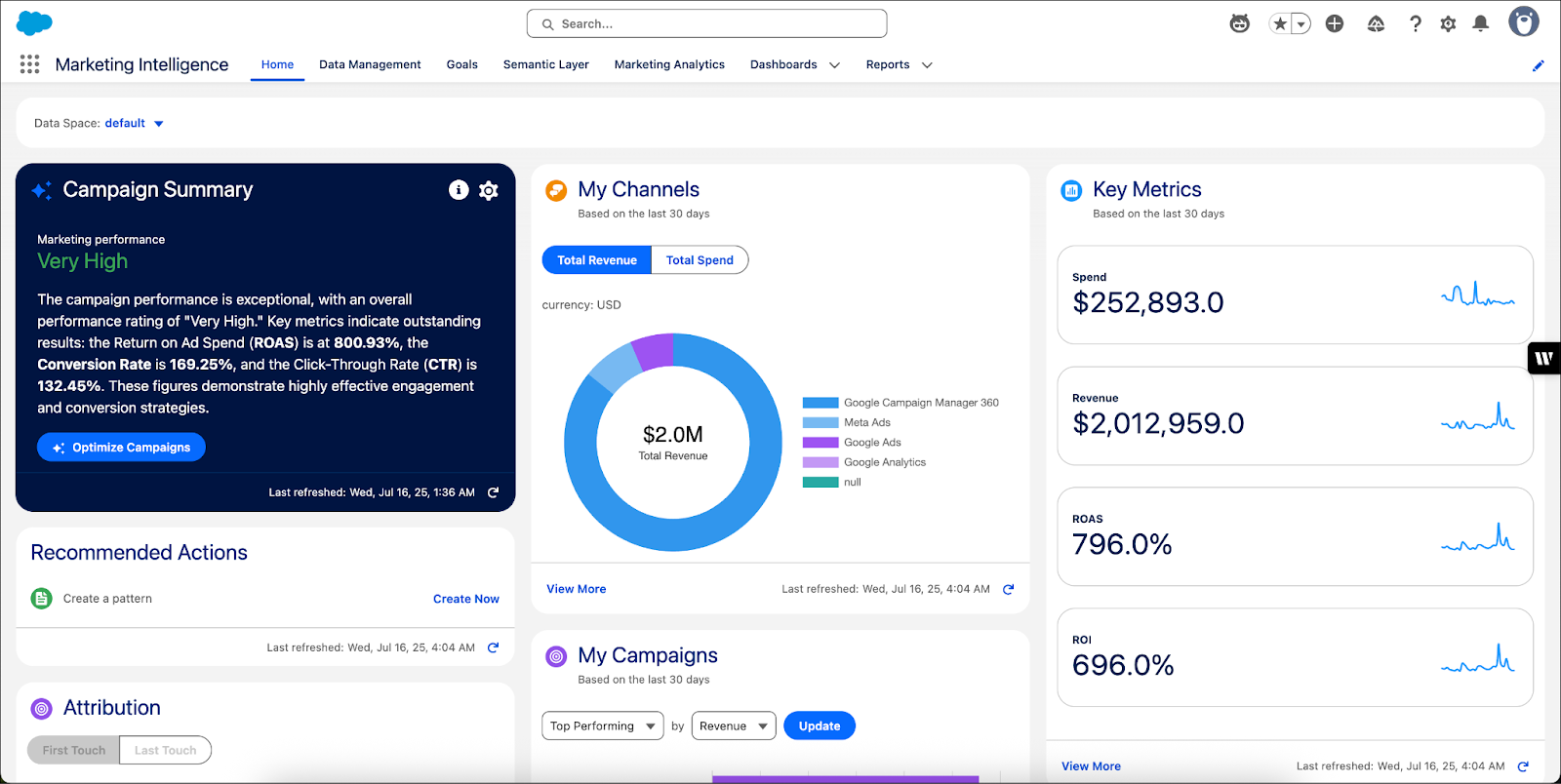Visualize and Act On Your Marketing Data
Learning Objectives
After completing this unit, you’ll be able to:
- View insights on your marketing data.
- Set and track KPIs using Marketing Intelligence Goals.
- Optimize ad performance with the Agentforce Paid Media Optimization Agent.
- Analyze campaign performance with dashboards.
Use Insights to Optimize Strategy
Alex now has clean, enriched data flowing into dashboards. But having data is only half the story—what matters most is turning that data into action.
With Marketing Intelligence, Alex uses the interactive home page to monitor data health and campaign performance. Alex sets specific goals to measure progress, activates the Agentforce Paid Media Optimization Agent to pause underperforming ads, and optimizes strategies with ready-to-use dashboards in the Marketing Analytics tab.
Let’s see how Alex turns insights into smarter decisions—and how you can, too.
View Insights on Your Data
The Marketing Intelligence home page is the command center for tracking campaign performance, data quality, and goals.
Upon login, Alex sees:
- A campaign summary with key metrics for a quick performance snapshot
- Acme Corp’s most important KPIs
- Alerts about data pipeline status
- Attribution overview
- Goals overview

To sharpen insights, Alex customizes the campaign summary to highlight six KPIs that matter most to Acme Corp. Alex sets high and low thresholds for each metric, creating a personalized view that surfaces trends and outliers.
With a clearer picture of overall performance, Alex is ready to define goals that track progress and keep the team focused on results.
Set and Track KPIs with Marketing Intelligence Goals (Beta)
With visibility into performance, Alex sets measurable goals to stay focused and drive impact. Marketing Intelligence Goals helps define and track KPIs such as increasing webinar sign-ups or lowering cost per acquisition (CPA).Note: Marketing Intelligence Goals is a beta feature and might not be available in your org yet.
Here’s how to create a goal:
- Navigate to the Goals tab in Marketing Intelligence.
- Click Create a Goal.
- Select the metric to target, such as conversions or clicks.
- Select one or more channels to base the goal on.
- Add filters if needed to focus on specific segments or campaigns.
- Set the target value and timeline (start and end dates).
- Preview the goal and click Save.

With goals in place, Alex monitors progress in real time and makes data-informed adjustments. These optimizations help drive stronger results and deliver higher ROI.
Optimize Campaigns with Agentforce Paid Media Optimization Agent
Managing ads across multiple channels can be overwhelming. Alex uses the Paid Media Optimization Agent to simplify this task. The agent automatically analyzes ad performance against industry or custom benchmarks, identifies underperforming ads, and can pause them on your behalf. The agent works across supported channels, saving time and improving campaign efficiency.
Alex reviews recommendations to pause specific ads directly in the platform. In supported channels, the agent can pause ads directly from Marketing Intelligence—with a human in the loop to acknowledge the recommendation. Pausing ads helps reallocate budgets to higher-performing campaigns without needing to switch to multiple ad managers. Alex sets up the Paid Media Optimization Agent to start optimizing campaigns:
- Enable Agentforce in Marketing Intelligence via the Feature Manager.
- Activate the Paid Media Optimization Agent from Agentforce Agents settings.
- Add the Paid Media topic from the Asset Library and activate the agent.
- Start optimizing campaigns with recommended pauses.
By automating ad optimization, Alex spends less time on manual performance monitoring and more time on strategy.
Analyze Campaign Performance with Dashboards
Alex now wants to see how Acme Corp’s campaigns perform across every channel. With Marketing Intelligence, Alex has ready-to-use dashboards that provide views that make it easy to analyze performance and uncover insights.
In the Marketing Analytics tab, Alex explores:
-
Performance Overview: A consolidated dashboard that brings together data from multiple sources into one report. Alex uses the campaign summary to quickly spot trends and identify which campaigns are driving results.
-
Channel Analytics: Dashboards for channels such as Facebook Ads, and Google Ads. Alex reviews key metrics like click-through rate (CTR), cost per click (CPC), and cost per acquisition (CPA), and tracks trends like conversions or CPA over time.
-
Segment Intelligence: A dedicated dashboard that shows how audience segments from Data Cloud perform once activated to platforms like Google Ads or Facebook Ads. Alex uses the Segment Summary to compare segment performance and refine targeting.
-
Attribution Dashboard: A dashboard that links campaigns with conversions, showing which touchpoints influence results. Alex customizes the view to analyze either first-touch or last-touch attribution.
To stay organized, Alex groups related dashboards into collections, making them easy to find and manage. Whether Alex is viewing cross-channel performance or segment-level trends, Alex and the team now have a clear and centralized view of what’s working and what needs to change.
With dashboards in place, Alex can move beyond surface-level metrics and use deeper insights to continuously optimize campaigns.
Wrap-Up
With dashboards, goals, and automation tools in Marketing Intelligence, Alex has the clarity and control to make smarter marketing decisions. Alex can track campaign performance, measure the impact on revenue, and use AI-driven insights to optimize data and outcomes. By connecting marketing data across platforms, setting measurable goals, and applying attribution models, Alex can confidently turn insights into action. You can use these same features to unlock the full potential of your campaigns and make data-driven decisions that drive real business impact.